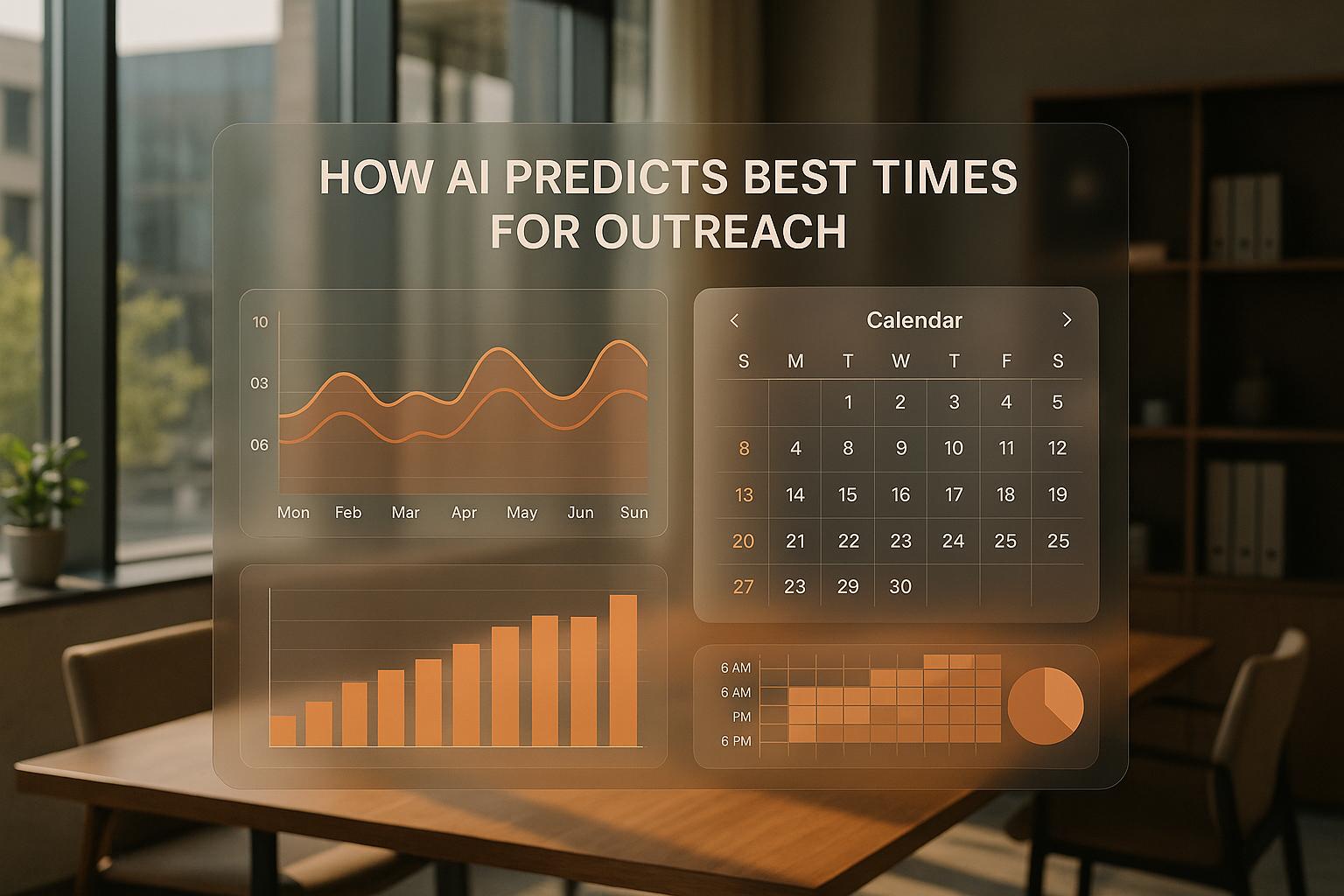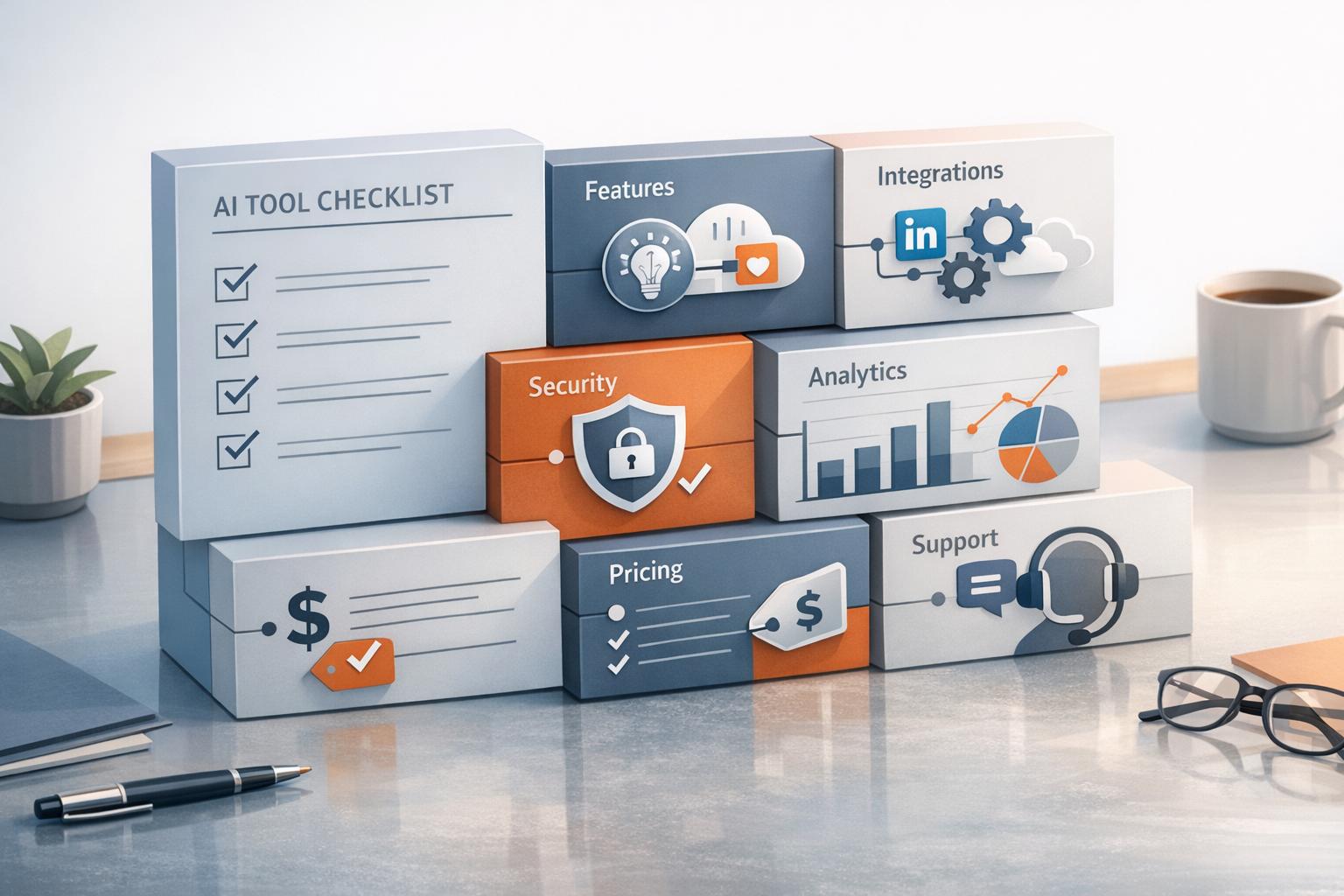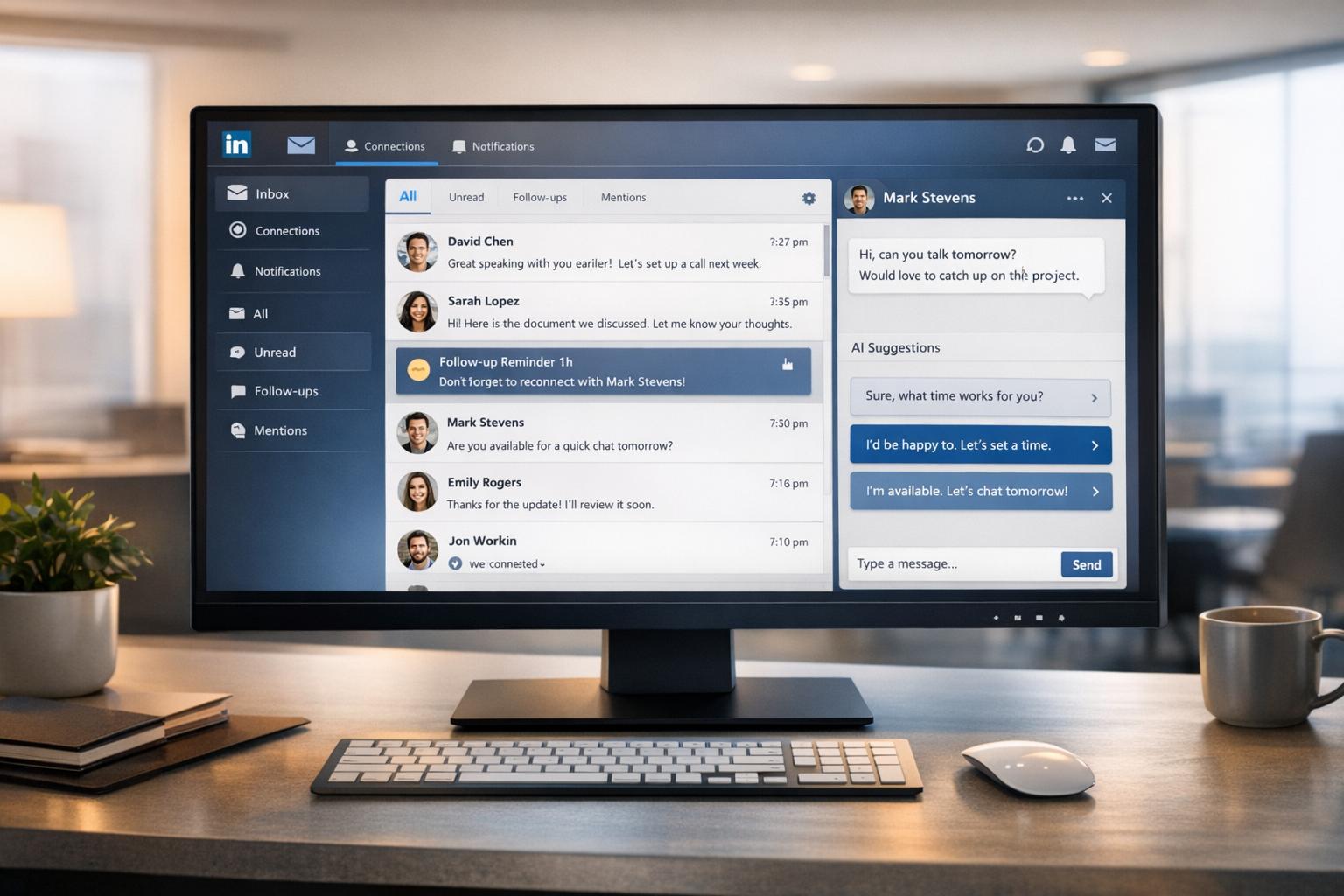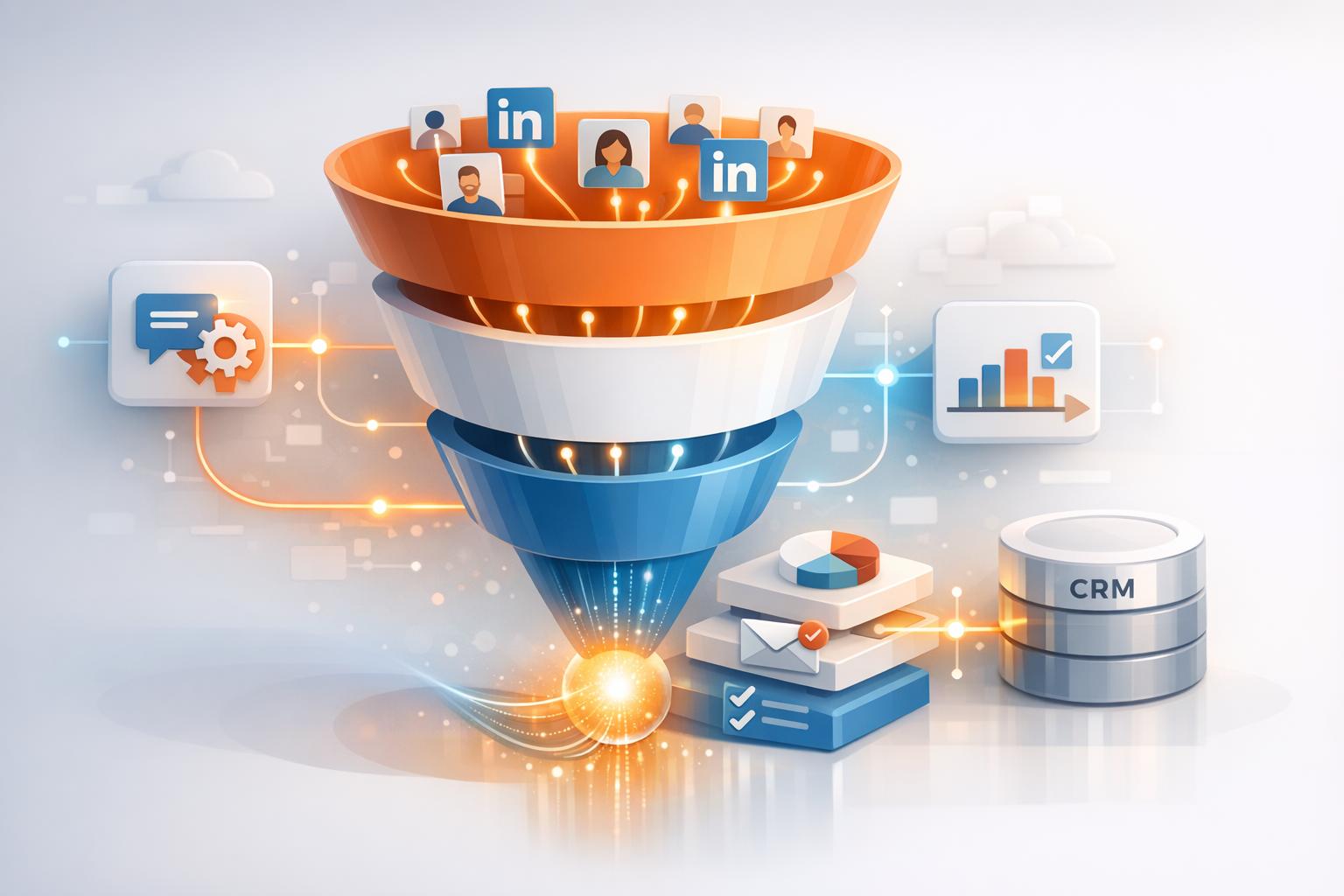
AI tools are changing how sales teams decide the best times to reach out to prospects. Instead of guessing or sticking to fixed schedules, these systems analyze data like email open rates, LinkedIn activity, and engagement patterns to recommend the ideal time for contact. The result? Higher response rates, better conversions, and more efficient outreach.
Key highlights:
- AI identifies when prospects are most likely to engage based on historical data and real-time signals.
- Companies report a 20–30% increase in open rates and up to a 15% jump in conversions with AI-driven timing.
- Tools like SalesMind AI use data from multiple channels (e.g., email, CRM, LinkedIn) to personalize outreach timing.
NEW AI Cold Outreach Methods to Get Clients Fast (2025)
How AI Predicts the Best Times for Outreach
AI takes the guesswork out of outreach timing by turning it into a data-driven process. By analyzing large datasets, it identifies patterns in engagement and uses them to pinpoint the best times to connect with prospects. This involves three main steps: collecting data from various sources, using predictive models to forecast optimal timing, and learning from ongoing interactions to refine its accuracy. Together, these elements create a system that adjusts outreach timing to fit each prospect's specific behavior.
Key Data Sources for AI Timing Predictions
AI pulls together data from multiple channels - email, LinkedIn, phone calls, and CRM systems - to map out how and when prospects engage. These patterns form the backbone of timing predictions, capturing details like when emails are opened or calls are returned. Time zone data also ensures messages arrive during business hours, improving the chances of engagement.
Role-based and industry-specific trends add another layer of precision. For example, executives might be more likely to respond to LinkedIn messages late in the afternoon, while individual contributors often check emails first thing in the morning. AI systems detect these tendencies and adjust outreach timing accordingly.
Real-time signals further refine the process. Events like company news, funding announcements, or a spike in LinkedIn activity can highlight the perfect moment for outreach. For instance, during earnings season, AI might recommend contacting a CFO earlier in the day when their schedule is more predictable.
Using Predictive Modeling for Timing Optimization
Machine learning algorithms analyze historical data to uncover patterns in prospect behavior, identifying the times when engagement is most likely. By sifting through thousands of interactions, these models reveal the best windows for open rates, responses, and conversions across different prospect groups.
A/B testing helps refine these predictions. For instance, if data shows that prospects in a specific industry engage more on Tuesday mornings, the system will test and validate this hypothesis to improve future recommendations.
AI also personalizes timing at the individual level. Instead of relying solely on general trends, it adapts to specific habits. For example, if a product manager typically checks emails during lunch breaks, the system will prioritize sending messages during that window, ensuring outreach feels timely and relevant.
Multi-channel optimization ensures that outreach aligns with each prospect's preferred communication method - whether it's email, LinkedIn, phone, or SMS. By timing messages just right across all channels, AI creates a cohesive and effective engagement strategy.
Continuous Learning and Adaptation
AI doesn’t stop at predictive modeling; it gets smarter with every interaction. Each time a prospect opens an email, responds to a message, or answers a call, the system updates its understanding of their behavior. This creates a feedback loop that continuously improves timing recommendations.
Behavioral changes are tracked automatically. For instance, if a prospect who usually engages in the morning stops doing so, the AI will experiment with different times and adjust its predictions. This adaptability ensures outreach strategies stay effective, even as habits shift.
Real-time adjustments make the system even more responsive. Whether it’s a sudden market trend, seasonal variation, or company-specific news, AI can quickly adapt its recommendations to match the new conditions.
As the system evolves, it also becomes better at filtering out irrelevant data, focusing on the signals that truly predict engagement. This ability to fine-tune its approach over time gives businesses a competitive edge. Instead of relying on guesswork, AI ensures outreach happens when prospects are most likely to respond, boosting engagement rates and driving better sales outcomes.
Step-by-Step Guide to Setting Up AI Timing Optimization
Implementing AI timing optimization involves three key phases: laying the groundwork, configuring the system, and launching your campaigns.
Setting Up AI-Powered Outreach Systems
Start by cleaning up your CRM data. Make sure duplicate contacts are removed, outdated information is updated, and essential details - like time zones, job titles, and company information - are complete. Without this clean foundation, even the smartest AI will struggle to generate accurate timing recommendations.
Next, focus on platform integration. Your AI needs access to a variety of data sources to create a full picture of your prospects' engagement patterns. Link your CRM, email platform, LinkedIn accounts, and phone systems to establish a unified data flow. This integration allows the AI to track interactions across all channels and uncover behavioral trends.
To train your AI's timing models, import a solid set of historical engagement data. Include metrics like email open rates, click-through rates, response times, and call connection rates. This historical data forms the basis for the AI's ability to predict optimal outreach times.
Once you've built a strong data foundation and connected your systems, you’re ready to configure the AI for tailored timing recommendations.
Configuring AI for Timing Recommendations
With clean, integrated data in place, you can fine-tune the AI to recognize unique timing patterns for different prospect segments. Start by defining these segments based on factors like industry, role, company size, and geographic location. By analyzing each group individually, the AI can uncover timing trends that might not be apparent when looking at your entire prospect base.
Set the AI to monitor key metrics such as email open times, LinkedIn views, call answer rates, and response patterns. Real-time data will continuously refine its timing recommendations.
Take advantage of personalization features to make the AI's timing suggestions more precise. Configure the system to consider factors like past interactions, company updates, and seasonal trends. For instance, if a prospect tends to respond to emails on Tuesday mornings, the AI will prioritize that time slot for future outreach.
It’s also crucial to define what success looks like for your outreach. Decide on key metrics - whether it’s email opens, replies, meeting bookings, or pipeline progression - and ensure the AI’s learning process aligns with these goals.
Launching and Monitoring Outreach Campaigns
Once your configurations are set, you’re ready to launch campaigns and monitor their performance. Start with a pilot campaign targeting a small, well-defined segment of your prospects. Choose a group with enough historical data for the AI to make accurate timing predictions.
Begin tracking performance as soon as the campaign launches. Keep an eye on metrics like open rates, reply rates, and conversion rates for different timing windows. Automated reporting tools can help you monitor results in real time, while alerts for shifts in engagement or unusual patterns can highlight new timing opportunities.
A/B testing is a powerful way to measure the AI’s impact. Run campaigns with AI-recommended timing alongside your usual approach to compare results. You can also experiment with different timing windows for specific segments to further refine the AI’s accuracy.
Periodic reviews are essential to keep improving. Analyze campaign results regularly to identify what’s working, and adjust the AI’s configuration based on new insights. Over time, as the AI processes more data, its recommendations often become even more precise.
"SalesMind AI has elevated my LinkedIn experience, offering exceptional customer service to maximize the impact of their product. Their team not only assisted with implementation but also provided insights to fine-tune my campaigns, enhance my profile's appeal, and boost lead acquisition." - Bennett Newhook, Founder, Outport [1]
Finally, ensure your outreach campaigns comply with regulations. The AI must respect prospect preferences, honor unsubscribe requests, and maintain appropriate contact frequency. This attention to compliance safeguards your reputation and supports long-term outreach success.
sbb-itb-817c6a5
Benefits of AI-Driven Timing Optimization
AI-driven timing optimization eliminates the guesswork from scheduling, replacing it with precise, data-backed strategies that yield tangible results. Sales teams that shift from manual scheduling to AI recommendations often see immediate improvements in key performance metrics, all while scaling personalized outreach without compromising quality.
Measurable Sales Improvements
The impact of AI timing optimization is clearly reflected in sales performance metrics. Companies adopting AI-powered outreach consistently report higher open rates, increased reply rates, and better conversion rates compared to traditional manual scheduling methods[2][3][5].
For example, a B2B tech company saw a 25% increase in meeting bookings and a 15% boost in closed deals within just three months of using AI-driven timing. By analyzing engagement patterns, the AI identified optimal contact windows previously overlooked by human schedulers[3][5].
Similarly, an insurance firm leveraged AI to schedule emails based on recipient behavior. By tracking when prospects typically opened emails, clicked on links, and replied to messages, the company achieved a 40% higher response rate compared to its manual efforts[3][5].
AI timing optimization ensures that messages reach prospects at moments when they’re most likely to engage. This not only shortens the sales cycle but also fosters more meaningful conversations. Time and again, performance metrics demonstrate that AI-driven timing outperforms manual scheduling decisions[2][3][5].
Beyond improving KPIs, AI also enables a level of scalable personalization that manual efforts simply can’t match.
Personalization at Scale
While traditional outreach often loses its personal touch as volume increases, AI timing optimization solves this issue by combining intelligent segmentation with dynamic messaging[4][5].
AI systems tailor timing recommendations to specific behavioral patterns. For instance, C-level executives may respond best to LinkedIn messages on Tuesday mornings, while procurement managers might prefer emails on Thursday afternoons. This level of precision allows for personalized communication that feels relevant to each recipient.
Platforms like SalesMind AI take this a step further by automating individualized LinkedIn messaging and follow-ups. Using CRM data, interaction history, and external insights, the system generates messages that address each prospect’s unique situation. This ensures that even large-scale campaigns maintain a personal, human-like touch[5].
AI doesn’t just stop at timing - it also crafts context-aware messaging. For example, it can reference recent company news, industry updates, or prior interactions to make each communication feel tailored and relevant. This approach allows sales teams to deliver the quality of one-on-one outreach while simultaneously engaging thousands of prospects.
What’s more, AI systems continuously learn and improve. As they process more engagement data, they refine their understanding of what resonates with different prospect segments. Over time, this leads to even more effective timing and messaging combinations[2][3].
| Feature | AI-Driven Outreach | Traditional Outreach |
|---|---|---|
| Timing Optimization | Predictive, data-driven | Manual, static |
| Personalization | Automated, scalable | Manual, limited |
| Performance Tracking | Real-time analytics | Periodic reviews |
| Adaptation Speed | Continuous learning | Slow manual adjustments |
Best Practices for Continuous Optimization
Using AI-driven timing insights is just the beginning. To truly maximize your outreach efforts, it's essential to continuously refine and scale your strategies. The best teams are always tweaking their AI systems to stay ahead, ensuring they adapt to new data and shifting prospect behaviors. Here's how systematic testing, regular reviews, and integrated data can take your outreach to the next level.
A/B Testing and Experimentation
Testing is key to figuring out what resonates most with your audience. By isolating one variable at a time, you can gain clear, actionable insights.
Start by focusing on timing variations. Test different hours or days to uncover the most effective windows for engagement. Make sure to run these tests for at least two weeks to collect enough data for meaningful results.
Once you've nailed the timing, shift your attention to message content variations. Experiment with subject lines, opening sentences, and call-to-action phrases while keeping the timing consistent. This approach helps you understand which messaging resonates with different audience segments.
Finally, explore frequency testing to determine the best cadence for your outreach. Some prospects might prefer daily follow-ups, while others respond better to weekly check-ins. Try varying the gaps between messages - such as 3, 5, or 7 days - to find what works best for each group.
Keep a close eye on performance, conducting monthly reviews and weekly check-ins during active campaigns to stay on top of trends and make adjustments as needed [6].
Regular Performance Reviews
Use automated dashboards to track key metrics in real time. Weekly check-ins allow for quick adjustments to tactics, while monthly deep dives help refine your overall strategy. Be sure to gather feedback from your sales team to align AI recommendations with actual engagement patterns [6].
Integration of Data Sources
Bringing together data from LinkedIn, email, and CRM systems gives you a unified view of prospect engagement. Real-time data integration eliminates silos, enabling the AI to make smarter, more accurate timing recommendations. Tools like SalesMind AI are designed to seamlessly connect these data points for consistent, data-driven optimization [1].
The quality of your data is critical. Start with clean, well-organized data, set clear campaign goals, and involve human oversight to validate AI insights. Regularly retrain your AI models using fresh data and feedback to ensure they stay relevant in a constantly changing market [6].
Conclusion
AI has completely transformed how sales teams handle outreach timing, replacing guesswork with precise, data-driven strategies. By analyzing patterns in prospect behavior, engagement history, and real-time signals, AI can pinpoint the best moments to reach out - moments when prospects are most likely to respond. This shift is about more than just timing; it’s about enabling meaningful and scalable interactions.
The benefits are clear: improved response rates, higher-quality leads, and increased efficiency. These results prove that optimizing timing with AI is a game-changer for staying competitive in sales. What’s more, AI systems continue to learn and refine their recommendations over time. With each interaction, the system gets smarter, adapting to changes in prospect behavior and ensuring outreach strategies remain effective and efficient.
"Amazing tool that allowed me to save so much time on my LinkedIn outreach. But that's not all, by automating all conversations and personalizing them with direct insights extracted from my prospect profiles, it gives accurate and high-quality outputs that helped me get more prospect meetings and thus close more deals!" - Sébastien D., Freelance, Freelance Insider [1]
If you’re looking to gain an edge, consider tools like SalesMind AI. This platform combines LinkedIn automation, lead scoring, and timing optimization to provide sales professionals with a unified solution. It’s designed to deliver the kind of integrated timing strategies discussed throughout this guide.
FAQs
How does AI figure out the best times to contact prospects, and what data does it analyze?
AI uses data to figure out the best times to connect with prospects by studying their behavior and engagement patterns. It examines things like email open rates, response times, website visits, and time zones to pinpoint when prospects are most likely to be active and responsive.
For instance, AI tools can analyze past interactions to see when a prospect typically opens emails or engages with content. By blending this information with broader industry trends, AI can suggest personalized outreach schedules that boost the chances of making a meaningful connection.
What are the advantages of using AI to optimize outreach timing compared to manual scheduling?
AI-powered timing tools take the guesswork out of scheduling by analyzing vast amounts of data to pinpoint the best times to connect with prospects. Instead of relying on limited historical insights or intuition, these tools examine behavioral patterns, engagement trends, and even time zones to predict when a prospect is most likely to respond.
By using AI, businesses can streamline their outreach efforts, boost response rates, and save valuable time. This approach removes the need for trial-and-error scheduling, freeing up teams to concentrate on building meaningful relationships with their prospects.
How can companies use AI to optimize outreach timing while staying compliant and respecting prospect preferences?
To ensure that AI-driven outreach respects prospect preferences and stays within legal boundaries, businesses should adopt a few essential practices.
First, keep up-to-date with laws and regulations like GDPR and CAN-SPAM to ensure all outreach efforts meet legal standards. Second, make consent a priority by securing explicit permission from prospects before reaching out. Third, choose AI tools that emphasize ethical data use and offer customization options tailored to your audience's needs.
Balancing compliance with personalized communication helps businesses build trust while optimizing the timing of their AI-driven outreach strategies.


.avif)


